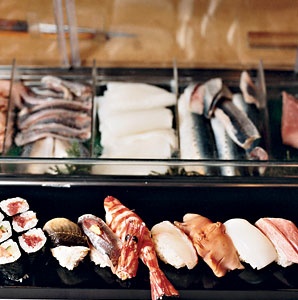 From sushi and yakitori to tempura, T+L offers a definitive guide to a food-obsessed city’s most authentic specialties.
From sushi and yakitori to tempura, T+L offers a definitive guide to a food-obsessed city’s most authentic specialties.
A highly ritualized, multicourse meal of “small bites,” kaiseki has evolved through the centuries as an offshoot of the Buddhist tea ceremony. Chef Yoshiaki Takahashi practices this culinary art at Kanetanaka-an, one of four Kanetanaka restaurants. This informal branch is hidden on the second floor of an office building. Request a seat at the varnished pine counter to watch him assemble an exquisite progression of seasonal dishes: chewy tofu skin with pale pink sea urchin; delicate shrimp cake adrift in matsutake mushroom broth. Takahashi also serves sakes in pottery cups he glazes himself. Dinner for two $320.
The nine-floor ride in a claustrophobic, battered elevator is well worth it: The doors open to Kondo, a Zen-calm dining room of muted tans and blond cedar presided over by fry master Fumio Kondo, revered for his secret-recipe batter. The chef dips a series of fresh vegetables and fish into polished bronze woks filled with roiling sesame oil; unblemished stalks of asparagus, fresh ginger buds, whole pink shrimp, and tiny goby fish all get the hot flash. One seasonal specialty is smoky shiitake mushrooms, farm-raised on cedar logs. For a finale, ask for the shredded carrot, inspired by a spun-sugar dome the chef tasted at one of Pierre Hermé’s patisseries in Paris. Dinner for two $180.
Around the corner from Hermès and Chanel, Sake Shop Fukumitsuya contains an informal bar that showcases fermented rice from the Fukumitsuya brewery, which was founded in 1625. The menu lists dozens of premium sakes and mirins, including several rare or aged vintages, served by the glass. Fruity Kagatobi Junmai Ginjo tastes like a fizzy Chablis, and Nipponia Nippon Daiginjo resembles rosé. On the snack menu, try pickled seafood or sake-kazu ice cream, made with residue from sake-brewing. Drinks for two $16.
Sequestered on a side street between the edgy fashion districts of Harajuku and Aoyama, Torimasa, a tiny, cheerful yakitori restaurant, provides welcome relief for famished shoppers roaming nearby Omotesando Hills. Free-range Nagoya Cochin chicken, a tender breed, is the specialty here. The set menu pairs miso soup and donburi—rice topped with five bamboo skewers of white or dark meat that are drizzled with tare sauce (made with mirin, sake, and soy) and grilled over natural charcoal. Garnish with scallions, searing-hot Japanese green peppers, or wasabi paste. The tsukune, or chicken meatballs, are best accompanied by cold Kirin beer. Lunch for two $20.
Bauhaus meets Bushido at Ogata’s Higashi-yama restaurant, where everything from the impeccable seafood concoctions to the décor is the product of a rigorously creative mind. The fatty-salmon salad drizzled with yuzu sauce is edible haiku. And Ogata puts a mod spin on the space, with a noirish lounge and an airy dining loft. He revives traditional craft techniques for his stunning table settings—curvaceous bronze soy-sauce ewers; glazed lotus-petal bowls; pewter chopstick stands—that emphasize the artistry of the set course menu. Dinner for two $200.
Surrounding the vast maze of refrigerated stalls in the centrally located Tsukiji fish market are simple spots that cater to off-duty fishmongers, still wearing their indigo overalls and insulated rubber boots. By 7 a.m. the auctions cease and some of the freshest catch winds up at Ryuzushi, a tiny diner with tiled walls and swivel stools facing a narrow slate-and-marble counter. Leave the menu up to the sushi chef, who has the inside track on tasty raw ingredients: red clam, mackerel, eel, sea urchin, and toro. Breakfast for two $50.
Japan’s traditional meal-ending confections, collectively known as wagashi, still have a passionate fan base. Often made with red-bean paste, sugar, and mochi (glutinous rice cakes), the treats were once a favored gift exchanged by samurai. The most sculptural form, namagashi, resembles cherry blossoms, fall foliage, ripe plums, or chestnut shells. Another version, rakugan, is usually pressed into wooden molds to create bite-size sweets, examples of which are on display at Higashiya, designer Shinichiro Ogata’s updated tearoom in Yakumo, in the Meguro neighborhood. At an equally sleek branch in Nishi-Azabu, snacks with inventive shapes and flavorings such as blueberry, macadamia, and brandy jelly offset bitter green tea. Wagashi for two $40.